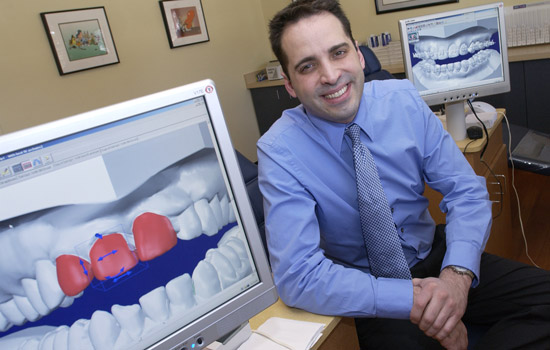Medicinal purpose
Orthodontist builds on engineering background
Brandon Comella ’97 uses 3-D computer modeling to help determine a course of treatment for patients.
After graduating from high school, Brandon Comella ’97 (B.S., M.S. mechanical engineering) joined the Air Force, “because I wanted to fly airplanes.”
He ultimately did receive a pilot’s license, but he discovered another passion while working as a dental technician for the USAF. By 1993, he knew he wanted to become an orthodontist. Perhaps surprisingly, his next step was engineering school.
“ Mechanical engineering is a great segue to orthodontics,” he explains. While at RIT, Comella worked as a technician for Roy Epstein Dental Lab in Webster.
He went on to study dentistry and work on his Ph.D. in engineering at the State University of New York in Buffalo. In 2001, he graduated from the dental program and started his career in orthodontics. After several years working at a dental practice in Buffalo, Comella opened his own office in Penfield, N.Y., in 2005.
He ’s putting his RIT education to good use.
“ One of the things that separates this practice is the high-tech engineering process I use to diagnose and determine treatment, ” he says.
The first step, making an impression of the patient’s teeth, is nothing new. Comella then sends the cast to a company in New Jersey that makes a digital, 3-D computer model of the teeth. Using the computer model, Comella can virtually place the brackets, wires and rubber bands and project how the teeth will respond over the course of treatment.
“ The computer program gives a demonstration of how the process starts and finishes,” he says. “If I’m not satisfied with the projected result, I can make adjustments before putting any hardware in the patient ’s mouth.”
In cases requiring surgery to correct severe problems affecting the jaw or bones of the face, he can determine precisely what needs to be done to achieve the desired result.
The computer technology improves the overall outcome and it also reduces the total amount of time the patient spends in the dentist’s chair, he says, adding that most people appreciate that.
Comella says this system has been in existence for several years, and is becoming more widely used. Besides the computer technology, advances in adhesives and in materials used in constructing the brackets and wires have revolutionized orthodontics. In addition, in setting up his office from scratch, he opted for digital radiography and an expanded Web site where patients can track their treatment.
At least part of his enthusiasm for the system comes from personal experience. While in dental school, he diagnosed his own treatment. Besides improving the appearance of his teeth, he was able to correct a problem with his nasal passages to improve breathing.
“I did the setup on the computer and had friends assist in the work,” he says. “It took about 1½ years, but I’m very pleased with how it turned out.”
For more information about Comella’s practice, visit the Comella Orthodontics website.










